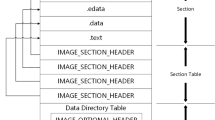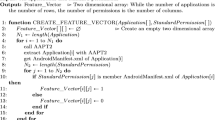Abstract
Android devices is emerging as a significant force for multimedia big data, which hold an enormous amount of information about the users. The security and privacy concerns have arisen as a salient area of inquiry since malicious attackers can use memory dump to extract privacy or sensitive data from these devices. This paper presents a code protection approach for Android devices which protects certain processes from memory acquisition by process memory relocation. The protected processes are relocated to the special memory area where the kernel is loaded, and thus these processes will be covered when android reboots and attackers can not recognize which protected programs have been performed on the devices. The experiment results show that the proposed approach disables forensics tools like FROST to obtain these processes and has little impact on the normal operation of the protected program. Compared with the similar methods, the proposed method can protect greater data quantity but it occupies no additional storage resources.








Similar content being viewed by others
References
Albano P, Castiglione A, Cattaneo G, Santis AD (2011) A novel anti-forensics technique for the android os. In: 2011 International Conference on Broadband and wireless computing, communication and applications (BWCCA). IEEE, pp 380–385
Anobah M, Saleem S, Popov O (2014) Testing framework for mobile device forensics tools. J Digital Forensics, Secur Law: JDFSL 9(2):221
Azadegan S, Wei Y, Liu H, Sistani M, Acharya S (2012) Novel anti-forensics approaches for smart phones. In: 2012 45th Hawaii International Conference on System Science (HICSS). IEEE, pp 5424–5431
Berghel H (2007) Hiding data, forensics, and anti-forensics. Commun ACM 50(4):15–20
Blunden B (2009) Anti-forensics: the rootkit connection. In: Black Hat USA 2009 Conference Proceedings. Citeseer, p 10
Caloyannides MA (2009) Forensics is so yesterday. IEEE Secur Priv 7(2):18–25
Chang X, Nie F, Wang S, Yi Y, Zhou X, Zhang C (2016) Compound rank- k projections for bilinear analysis. IEEE Trans Neural Netw Learning Syst 27(7):1502–1513
Chang X, Ma Z, Lin M, Yang Y, Hauptmann A (2017) Feature interaction augmented sparse learning for fast kinect motion detection. IEEE Trans Image Processing 26(8):3911–3920
Chang X, Ma Z, Yi Y, Zeng Z, Hauptmann AG (2017) Bi-level semantic representation analysis for multimedia event detection. IEEE Trans Cybern 47(5):1180–1197
Chang X, Yao-Liang Y, Yi Y, Xing EP (2017) Semantic pooling for complex event analysis in untrimmed videos. IEEE Trans Pattern Anal Mach Intell 39(8):1617–1632
Conlan K, Baggili I, Breitinger F (2016) Anti-forensics: Furthering digital forensic science through a new extended, granular taxonomy. Digit Investig 18:S66–S75
Distefano A, Me G, Pace F (2010) Android anti-forensics through a local paradigm. Digit Investig 7:S83–S94
Garfinkel S (2007) Anti-forensics: techniques, detection and countermeasures. In: 2Nd International Conference on i-Warfare and Security, p 77
Geiger M (2005) Evaluating commercial counter-forensic tools. In: DFRWS
Götzfried J, Müller T (2013) Armored: cpu-bound encryption for android-driven arm devices. In: 2013 eighth international conference on Availability, reliability and security (ARES). IEEE, pp 161–168
Gupta S, Gupta BB (2017) Detection, avoidance, and attack pattern mechanisms in modern web application vulnerabilities: present and future challenges. International Journal of Cloud Applications and Computing (IJCAC) 7(3):1–43
Gupta BB, Gupta S, Chaudhary P (2017) Enhancing the browser-side context-aware sanitization of suspicious html5 code for halting the dom-based xss vulnerabilities in cloud. International Journal of Cloud Applications and Computing (IJCAC) 7(1):1–31
Harris R (2006) Arriving at an anti-forensics consensus: examining how to define and control the anti-forensics problem. Digit Investig 3:44–49
Ibtihal M, Hassan N et al (2017) Homomorphic encryption as a service for outsourced images in mobile cloud computing environment. International Journal of Cloud Applications and Computing (IJCAC) 7(2):27–40
Jansen W, Delaitre A, Moenner L (2008) Overcoming impediments to cell phone forensics. In: Proceedings of the 41st Annual Hawaii International Conference on System Sciences. IEEE, pp 483–483
Karlsson K-J, Glisson WB (2014) Android anti-forensics: modifying cyanogenmod. In: 2014 47Th Hawaii International Conference on System Sciences. IEEE, pp 4828–4837
Kessler GC (2007) Anti-forensics and the digital investigator. In: Australian Digital Forensics Conference, p 1
Lee K, Choi HO, Min SD, Lee J, Gupta BB, Nam Y (2017) A comparative evaluation of atrial fibrillation detection methods in koreans based on optical recordings using a smartphone. IEEE Access
Liu V, Brown F (2006) Bleeding-edge anti-forensics presentation at InfoSec World
Liu H, Azadegan S, Yu W, Acharya S, Sistani A (2012) Are we relying too much on forensics tools?. In: Software Engineering Research, Management and Applications 2011. Springer, pp 145–156
Müller T, Spreitzenbarth M (2013) Frost. In: International Conference on Applied Cryptography and Network Security. Springer, pp 373–388
Müller T, Dewald A, Freiling FC (2010) Aesse: a cold-boot resistant implementation of aes. In: Proceedings of the Third European Workshop on System Security. ACM, pp 42–47
Müller T, Freiling FC, Dewald A (2011) Tresor runs encryption securely outside ram. In: USENIX Security Symposium, vol 17
Müller T, Taubmann B, Freiling FC (2012) Trevisor. In: International Conference on Applied Cryptography and Network Security. Springer, pp 66–83
Nilsson A, Andersson M, Axelsson S (2014) Key-hiding on the arm platform. Digit Investig 11:S63– S67
Peron CSJ, Legary M (2005) Digital anti-forensics: emerging trends in data transformation techniques. In: Proceedings of
Rastogi S, Bhushan K, Gupta BB (2015) A framework to detect repackaged android applications in smartphone devices. Int J Sens Wireless Commun Control 5(1):47–57
Rastogi S, Bhushan K, Gupta BB (2016) Android applications repackaging detection techniques for smartphone devices. Procedia Comput Sci 78:26–32
Sharma K, Gupta BB (2016) Multi-layer defense against malware attacks on smartphone wi-fi access channel. Procedia Comput Sci 78:19–25
Simmons P (2011) Security through amnesia: a software-based solution to the cold boot attack on disk encryption. In: Proceedings of the 27th Annual Computer Security Applications Conference. ACM, pp 73–82
Sporea I, Aziz B, McIntyre Z (2012) On the availability of anti-forensic tools for smartphones. Int J Secur 6(4):58–64
Stüttgen J, Cohen M (2013) Anti-forensic resilient memory acquisition. Digit Investig 10:S105–S115
Sun Z, Zhang Q, Li Y, Tan Y (2016) Dppdl: a dynamic partial-parallel data layout for green video surveillance storage. IEEE Transactions on Circuits and Systems for Video Technology PP(99):1–1
Sylve J, Case A, Marziale L, Richard GG (2012) Acquisition and analysis of volatile memory from android devices. Digit Investig 8(3):175–184
Thing VLL, Ng K-Y, Chang E-C (2010) Live memory forensics of mobile phones. Digit Investig 7:S74–S82
Wundram M, Freiling FC, Moch C (2013) Anti-forensics: the next step in digital forensics tool testing. In: 2013 Seventh International Conference on IT Security Incident Management and IT Forensics
Xiao Y, Zhang C, Xue Y, Zhu H, Li Y, Tan Y (2017) An extra-parity energy saving data layout for video surveillance. Multimed Tool Appl. https://doi.org/10.1007/s11042-017-4540-1
Xue Y, Tan Y, Liang C, Zhang C, Zheng J (2017) An optimized data hiding scheme for deflate codes. Soft Comput. https://doi.org/10.1007/s00500-017-2651-2
Yan F, Tan Y, Zhang Q, Fei W, Cheng Z, Zheng J (2016) An effective raid data layout for object-based de-duplication backup system. Chin J Electron 25(5):832–840
Zhang X, Tan Y, Xue Y, Zhang Q, Li Y, Zhang C, Zheng J (2017) Cryptographic key protection against frost for mobile devices. Clust Comput 20(3):2393–2402
Zhu H, Tan Y, Zhang X, Zhu L, Zhang C, Zheng J (2017) A round-optimal lattice-based blind signature scheme for cloud services. Futur Gener Comput Syst 73(C):106–114
Zhu R, Tan Y, Zhang Q, Li Y, Zheng J (2016) Determining image base of firmware for arm devices by matching literal pools. Digit Investig 16:19–28
Zhu R, Zhang B, Mao J, Zhang Q, Tan Y (2017) A methodology for determining the image base of arm-based industrial control system firmware. Int J Crit Infrastruct Prot 16:36–35
Zkik K, Orhanou G, Hajji SE (2017) Secure mobile multi cloud architecture for authentication and data storage. International Journal of Cloud Applications and Computing (IJCAC) 7(2):62–76
Acknowledgements
This research was supported by the National Natural Science Foundation of China (No.U1636213), Beijing Municipal Natural Science Foundation (No.4172053).
Author information
Authors and Affiliations
Corresponding author
Rights and permissions
About this article
Cite this article
Zhang, X., Tan, Ya., Zhang, C. et al. A code protection scheme by process memory relocation for android devices. Multimed Tools Appl 77, 11137–11157 (2018). https://doi.org/10.1007/s11042-017-5363-9
Received:
Revised:
Accepted:
Published:
Issue Date:
DOI: https://doi.org/10.1007/s11042-017-5363-9




